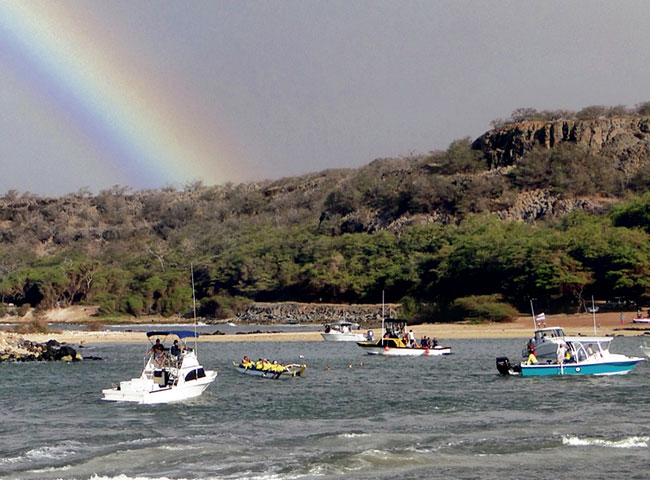Dangerous Start To Women’s Race
Every year Sherry Tancayo and dozens of Moloka’i residents make the drive to Hale O Lono Harbor to wish hundreds of wahine paddlers a safe crossing as they set off on their 41-mile race from Moloka’i to Oahu. his year was no different.
“I’ve been saying aloha to the wahine at Hale O Lono for 16 years,” says Tancayo. “It’s always exciting to be there for the start of the race.”
The start of the 2012 race may go down in history as the most exciting starts ever; it certainly was the most memorable.
The race from Moloka’i to Oahu is often considered the world championship of long-distance outrigger canoe racing as paddlers take on one of the most treacherous and unpredictable channels in the world, the Kaiwi Channel.
This year, Hale O Lono Harbor was just as unpredictable. A potent northwest swell had arrived overnight, prompting race officials to warn crews to “time the sets” as they exited the harbor. Tancayo was among a group of people watching from the shore with keen interest as the women navigated their way out of the harbor to the starting line.
“Then all of a sudden I looked outside and saw huge waves coming in,” recalls Tancayo who instinctively grabbed her camera. “We were yelling at the paddlers, ‘Hurry up!'”
But it was too late. By then, nearly a dozen crews were feverishly scratching for the horizon as waves estimated between 10 to 12 feet started to feather. Several other crews started paddling toward the channel in an effort to outrun the approaching set of waves. Tancayo was focused on two canoes that had no choice but to plow forward. The massive wave closed out the entire channel and consumed the 40-foot fiber-glass canoes.
“I just started taking pictures,” says Tancayo. “I was standing there and I couldn’t believe what I was seeing. I have never seen anything like it before. I give those women credit, especially the crews from Pu’uwai and Kailua (canoe clubs) because they took the brunt of it. Pu’uwai tried to punch through it, but they were thrown back into another canoe!”
Clare Seeger Mawae was on the opposite end of the harbor and, like Tancayo, was catching the action on camera.
“That was something else,” says Mawae. “My camera was fogging up, so I was hoping the pictures were coming out. Those women are extremely tough.”
Both Tancayo and Mawae continued to snap pictures as the women scrambled to safety. A second wave slammed the crews that were either swamped or had flipped over completely.
Witnesses say the giant set overpowered 10 canoes. Amazingly, nine of them went on to start and eventually finish the race. One canoe was damaged and was towed back to shore.
A 30-year-old windward Oahu paddler was transported by ambulance to Moloka’i General Hospital with injuries to her ribs and shoulder.
“I’m happy no one was seri ously injured because it easily could have happened,” says Mawae.
“I’ve been to many races before and this was a first,” adds Tancayo.
Tancayo and Mawae’s photos quickly spread on Facebook and other social media sites. The pictures later surfaced on news reports all across the nation.
Tancayo and Mawae had captured images of one of the most memorable moments in Na Wahine O Ke Kai history.
“I wanted the women to see what they went through,” says Tancayo. “The women earned the respect of many people. If you don’t believe, take a look for yourself! I give them credit.”
Credit. Respect. The pictures don’t lie!






